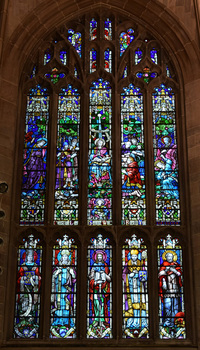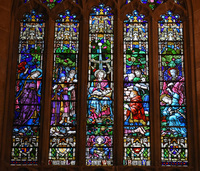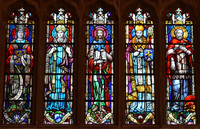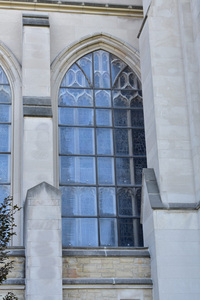Window
Building Name: Cathedral of the Most Blessed SacramentStudio Name: Willet Hauser Architectural Glass
City: Detroit
Window Shape: 6 (gothic arched, more than 2 vertical sections)
Subject/Title of Window: The Nativity of Christ
Brief Description of Subject: The canopy topping this five panel window is decorative in nature highlighted by angels with a censer.
The scene below is topped with decorative inscriptions based on Matt.28:4-5 -- the resurrection scene where the two Mary's had come to anoint the body of Jesus and an angel had appeared at the tomb "And for fear of him the guards trembled and became like dead men. But the angel said to the women 'Do not be afraid, for I know you seek Jesus.'" The Nativity scene depicted here is rather unique as it does not center on the Holy Family -- notice that Joseph (far right) is away from the center of attention, rather the artist has incorporated a verse from the Magnificat into the design -- "He hath put down the mighty from their seat, and hath exalted the humble." Surrounded by shepherds and angels the Madonna and Child are seated and a man dressed as a rich (mighty) man is seen kneeling and giving homage to the Messiah; a crown can be seen at the feet of the Virgin Mary. Below the scene are decorative coats-of-arms as befitting a Norman styled church as well as an angel holding a crown symbolizing Christ the King.
The inscription below paraphrasing Luke 2:11 reads "Christ the Lord a Saviour who is born to you".
At the lower portion of the window is depicted five saints with the artist's creation of their coat-of-arms.
St. Gregory (c.550-604) was a pope and chiefly known for writing the "Dialogues" as well as codifying the prayers of the Mass and liturgical music (Gregorian Chant). Attributes seen here are the papal tiara, music scroll, book, and dove (Holy Spirit) in his coat-of-arms.
St. Ambrose (340-396) became Bishop of Milan and a Doctor of the Church for his extensive writing. His attributes seen here are dressed as a bishop with crosier, pen, and a whip seen in the coat-of-arms. The whip comes from legend that after his death when Milan was under attack he appeared riding a horse and caused the enemy to flee using a whip.
St. James the Elder (martyred c.95) was one of the twelve apostles and wrote an Epistle. He preached in Spain and when he returned to Jerusalem he was killed with a sword. His body was returned to Spain where a church was built to contain his remains. This church, Cathedral de Santiago de Compostella, became and still is a major pilgrimage destination. His attributes seen here are a book, a pilgrim's water flask, and in the coat-of-arms a sword and a pilgrim's staff and purse.
St. Augustine (354-430) became the Bishop of Hippo and is known for his spiritual writings. His attributes seen here are costumed as a bishop with crosier, a book, and a shell in the coat-of-arms. The shell comes from his thoughts on the mystery of the Trinity that trying to understand it was like trying to pour the sea into a hole with a shell.
St. Jerome (c.340-429) was an ascetic and biblical scholar. He is best known today for translating the Bible into Latin (the Vulgate). He was a close advisor to Pope Damasus and although the rank of "Cardinal" did not yet exist legend would ascribe that position to him. He would often go into the catacombs to remind himself of his own mortality. His attributes seen here are a book, dressed as a Cardinal (note discarded hat shows humility), and in the coat-of-arms -- a skull (mortality).
From the Guide to the Cathedral of the Most Blessed Sacrament, Copyright 1958, Archdiocese of Detroit.
The center panel shows the Blessed Virgin Mary holding the Divine Infant while the shepherds bow in adoration to the immediate right and left. In the outside panels, angels proclaim the birth of the Saviour on the first Christmas night. Beneath the principal panels stand St. Gregory the Great, St. Ambrose, St. James the Elder, St. Augustine, and St. Jerome.
Inscriptions: Christ, the Lord Saviour, who is born to you
Deposuit potentes de Sede
Translation: He hath put down the mighty from their seat
The Nativity of Christ
The Nativity of Christ scene
The Nativity of Christ, Saints
The Nativity of Christ outside
The MSGC is a constantly evolving database. Not all the data that has been collected by volunteers has been sorted and entered. Not every building has been completely documented.
All images in the Index are either born-digital photographs of windows or buildings or are scans of slides, prints, or other published sources. These images have been provided by volunteers and the quality of the material varies widely.
If you have any questions, additions or corrections, or think you can provide better images and are willing to share them, please contact donald20@msu.edu






